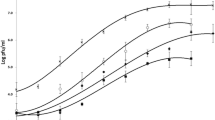Abstract
As the most abundant biological entities, viruses are major players in marine ecosystems. However, our knowledge about virus-host interactions and viral ecology in the deep sea remains very limited. In this study, a novel bacteriophage (designated as phage BVE2) infecting Bacillus cereus group bacteria, was isolated from deep-sea sediments. Phage BVE2 caused host lysis within 1.5 h after infection. However, the presence of two integrase-encoding genes in the BVE2 genome suggested that BVE2 may also follow a temperate strategy. The genome of phage BVE2 is approximately 20 kb in length and is predicted to encode 28 proteins. Genomic and phylogenetic analysis suggested that BVE2 is a highly mosaic phage that has inherited genetic features from Wbeta-like viruses, B. cereus prophages, and its host, suggesting that frequent horizontal gene transfer events occurred during its evolution. This study will help to reveal the evolutionary history of Wbeta-like viruses and improve our understanding of viral diversity and virus–host interactions in the deep sea.


Similar content being viewed by others
References
Adams M, Lefkowitz E, King A, Bamford D, Breitbart M, Davison A, Ghabrial S, Gorbalenya A, Knowles N, Krell P (2015) Ratification vote on taxonomic proposals to the International Committee on Taxonomy of Viruses (2015). Arch Virol 160(7):1837–1850
McCloy EW (1951) Studies on a lysogenic Bacillus strain. IA bacteriophage specific for Bacillus anthracis. Epidemiol Infect 49(1):114–125
Brown ER, Cherry WB (1955) Specific identification of Bacillus anthracis by means of a variant bacteriophage. J Infect Dis 96(1):34–39
Schuch R, Nelson D, Fischetti VA (2002) A bacteriolytic agent that detects and kills Bacillus anthracis. Nature 418(6900):884
Minakhin L, Semenova E, Liu J, Vasilov A, Severinova E, Gabisonia T, Inman R, Mushegian A, Severinov K (2005) Genome sequence and gene expression of Bacillus anthracis Bacteriophage Fah. J Mol Biol 354(1):1–15
Raymond S, Fischetti VA (2006) Detailed genomic analysis of the Wbeta and gamma phages infecting Bacillus anthracis: implications for evolution of environmental fitness and antibiotic resistance. J Bacteriol 188(8):3037–3051
Fouts DE, Rasko DA, Cer RZ, Jiang L, Fedorova NB, Shvartsbeyn A, Vamathevan JJ, Tallon L, Althoff R, Arbogast TS (2006) Sequencing Bacillus anthracis typing phages gamma and cherry reveals a common ancestry. J Bacteriol 188(9):3402–3408
Ackermann HW (2001) Frequency of morphological phage descriptions in the year 2000. Arch Virol 146(5):843–857
Garneau JR, Depardieu F, Fortier LC, Bikard D, Monot M (2017) PhageTerm: a tool for fast and accurate determination of phage termini and packaging mechanism using next-generation sequencing data. Sci Rep 7(1):8292
Paez-Espino D, Chen I-MA, Palaniappan K, Ratner A, Chu K, Szeto E, Pillay M, Huang J, Markowitz VM, Nielsen T (2016) IMG/VR: a database of cultured and uncultured DNA viruses and retroviruses. Nucleic Acids Res 45(D1):D457–D465
Ivanova N, Sorokin A, Anderson I, Galleron N, Candelon B, Kapatral V, Bhattacharyya A, Reznik G, Mikhailova N, Lapidus A (2003) Genome sequence of Bacillus cereus and comparative analysis with Bacillus anthracis. Nature 423(6935):87
Rocha EP, Danchin A (2002) Base composition bias might result from competition for metabolic resources. Trends Genet 18(6):291–294
Lawrence JG, Hatfull GF, Hendrix RW (2002) Imbroglios of viral taxonomy: genetic exchange and failings of phenetic approaches. J Bacteriol 184(17):4891–4905
Turner IJ, Scott DJ, Allen S, Roberts CJ, Soultanas P (2004) The Bacillus subtilis DnaD protein: a putative link between DNA remodeling and initiation of DNA replication. FEBS Lett 577(3):460–464
Jin M, Ye T, Zhang X (2013) Roles of bacteriophage GVE2 endolysin in host lysis at high temperatures. Microbiology SGM 159(8):1597–1605
Dziewit L, Monika R (2016) Two inducible prophages of an Antarctic Pseudomonas sp. ANT_H14 use the same capsid for packaging their genomes—characterization of a novel phage helper-satellite system. PLoS One 11(7):e0158889
Thompson LR, Zeng Q, Kelly L, Huang KH, Singer AU, Stubbe J, Chisholm SW (2011) Phage auxiliary metabolic genes and the redirection of cyanobacterial host carbon metabolism. Proc Natl Acad Sci USA 108(39):757–764
Hurwitz BL, U’Ren JM (2016) Viral metabolic reprogramming in marine ecosystems. Curr Opin Microbiol 31:161–168
Jin Min, Xun Guo, Rui Zhang WuQu, Gao Boliang, Zeng Runying (2019) Diversities and potential biogeochemical impacts of mangrove soil viruses. Microbiome 7:58
Brüssow H, Canchaya C, Hardt W-D (2004) Phages and the evolution of bacterial pathogens: from genomic rearrangements to lysogenic conversion. Microbiol Mol Biol R 68(3):560–602
Acknowledgements
This work was financially supported by the China Ocean Mineral Resources R&D Association (DY135-B-04), the Scientific Research Foundation of the Third Institute of Oceanography, MNR (2019013), and the National Natural Science Foundation of China (41976084, 31702372).
Author information
Authors and Affiliations
Corresponding author
Ethics declarations
Conflict of interest
The authors declare that they have no competing interests.
Nucleotide sequence accession number
The complete genome sequence of phage BVE2 was deposited in the GenBank database under the accession number MG584725.1.
Experimental methods
Detailed experimental methods are provided in Supplementary Materials.
Additional information
Handling Editor: Johannes Wittmann.
Publisher's Note
Springer Nature remains neutral with regard to jurisdictional claims in published maps and institutional affiliations.
Electronic supplementary material
Below is the link to the electronic supplementary material.
Rights and permissions
About this article
Cite this article
Chen, Y., Guo, X., Wu, J. et al. A novel deep-sea bacteriophage possesses features of Wbeta-like viruses and prophages. Arch Virol 165, 1219–1223 (2020). https://doi.org/10.1007/s00705-020-04579-6
Received:
Accepted:
Published:
Issue Date:
DOI: https://doi.org/10.1007/s00705-020-04579-6




